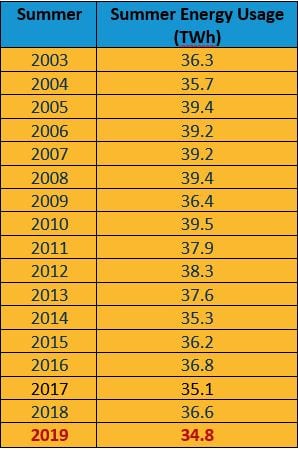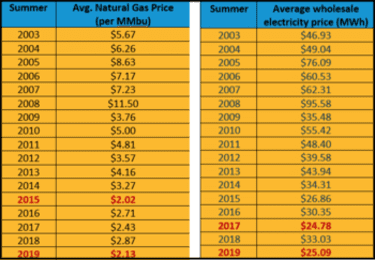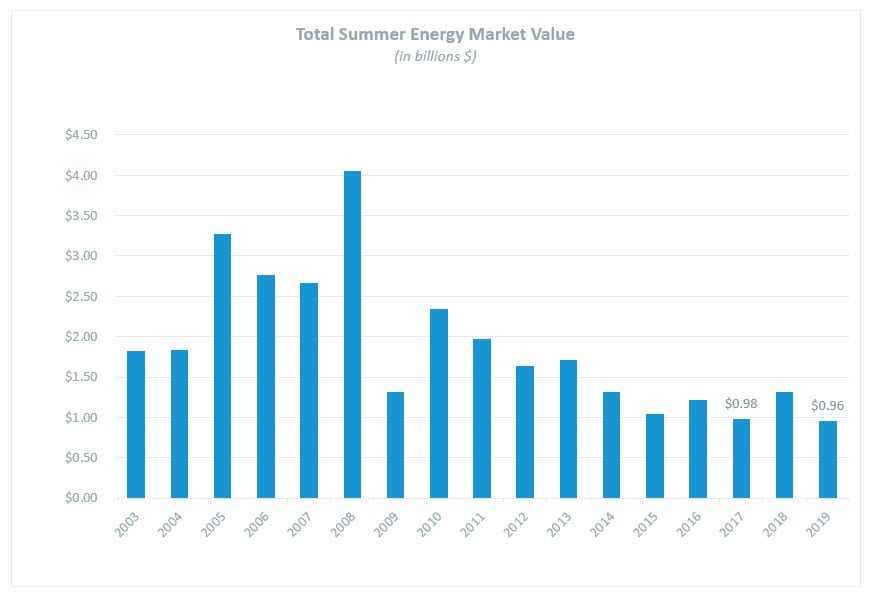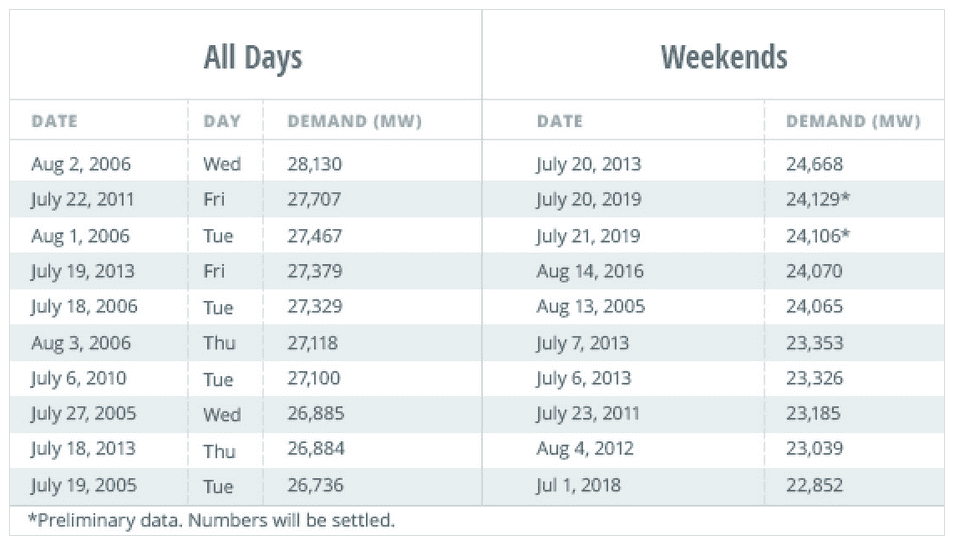Summer 2019: Lowest regional grid electricity use in at least 16 years
 Despite a hot July, New England saw the lowest summer season grid demand and the second lowest wholesale pricing since 2003
Despite a hot July, New England saw the lowest summer season grid demand and the second lowest wholesale pricing since 2003
During the summer of 2019, New England homes and businesses used the lowest total amount of grid electricity of any summer season since at least 2003 and that, combined with extremely low natural gas prices, resulted in the second lowest energy market pricing since 2003.
 Cool weather, low load in June
Cool weather, low load in June
Real-time load obligation (RTLO), a measure of the amount of electricity that wholesale market participants must buy to serve their customers, totaled 34,800 gigawatt-hours (GWh) over the course of the summer, the lowest value since at least 2003 (the year the current structure of wholesale markets went into effect). The start of the summer saw relatively cool average temperatures, helping bring down the season’s total energy usage. RTLO during June 2019 totaled 9,970 GWh, the lowest for any summer month since at least 2003.
Wholesale prices low
 The two main drivers of wholesale electricity prices are the cost of fuel used to produce electricity and consumer demand. Natural-gas-fired power plants generate 49% of the power produced in New England. As a result, average wholesale electricity prices are closely linked to natural gas prices.
The two main drivers of wholesale electricity prices are the cost of fuel used to produce electricity and consumer demand. Natural-gas-fired power plants generate 49% of the power produced in New England. As a result, average wholesale electricity prices are closely linked to natural gas prices.
During the summer of 2019, natural gas prices averaged $2.13 per million British thermal unit, the second-lowest price recorded since 2003. The average real-time wholesale electricity price of $25.09/MWh was the second-lowest during a summer season, behind only 2017 at $24.78/MWh.
The combination of record-low load levels and second-lowest gas prices resulted in the region’s lowest energy market value during any summer since at least 2003, at $964 million.

Historically hot weekend in July
The record setting low-demand and moderate temperatures were not uniform throughout the summer, however. New England grid electricity demand peaked at 24,300 MW on Tuesday, July 30, during the 5 p.m. to 6 p.m. hour when the average temperature in New England was 89°F and the dewpoint was 69°F.
Saturday and Sunday, July 20-21, saw the highest average temperature and heat index readings in New England for any weekend in the past 20 years. And both Saturday and Sunday’s peak grid demand were among the ten highest weekend loads in recent history. Temperatures soared upwards of 100°F in Hartford, Connecticut on July 21, and Portland, Maine recorded a record-high temperature of 99°F on the same day. The combination of high temperatures and humidity led to a regional peak grid demand of 24,129 MW on Saturday during the 7 pm. hour and 24,106 MW on Sunday.
Had the July 20-21 weekend heat had occurred on a weekday, ISO New England Forecasters estimate that demands could have fallen within the top ten highest demand days. With identical temperatures and dew points, models estimated the hypothetical midweek load on the previous Thursday would have been over 26,000 MW.

Solar PV impact
The growing number of behind-the-meter photovoltaic (BTM PV) arrays is also having a significant impact on demand for power from the regional grid as these rooftop systems produce power for the homes and businesses upon which they’re installed. For example, the recorded peak on July 30 would have been almost 1,000 MW higher without the region’s BTM PV.
As energy-efficiency measures and BTM PV resources proliferate, demand for electricity from the regional grid declines and records become more difficult to exceed; the all-time record peak of 28,130 MW was set thirteen years ago in August of 2006. Although the top ten weekday peaks are unchanged since 2013, spikes in demand can still occur.
- Categories
- Industry News & Developments
- Tags
- summer



